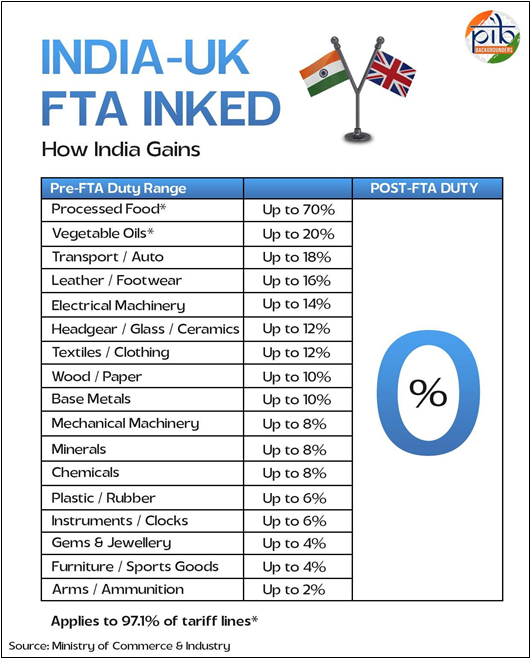The UK-India CETA, signed on 26 July 2025, is a significant achievement and a cause for optimism in the economic and diplomatic relations between the two countries. It is the culmination of years of detailed negotiations and is likely to lead to a considerable growth in trade between the two nations. At a time of increased geopolitical tensions, trade barriers and a perceived retreat from globalisation, the UK-India CETA is a welcome development for businesses in both countries.
For the UK government, it is the fulfilment of its manifesto commitment to secure a free trade deal with India and to deepen its ties with its 11th largest trade partner. For the Indian government, it is seen as a catalyst for India's ambitious target to sustain its position as one of the world's most rapidly growing economies.
A snapshot of the CETA
The CETA is what is commonly known as a 'free trade agreement' between two countries. Its objective is to soften barriers to the trade of goods and services. The CETA has the typical features of a free trade agreement but also has some unique provisions on topics such as innovation and gender equality.
Tariff Reductions
The tariff reductions from both sides are unprecedented.
Amongst the most widely-reported features of the CETA which benefits the UK economy is the reduction in Indian import duties on whisky and gin from the UK from 110% to 75% as soon as the CETA comes into force and down to 40% in the next stage. The import duties in India on specified UK manufactured car engines will also reduce from 110% to 10% in phases. Other UK goods which will benefit from significant tariff reductions include agrifood (fresh and frozen salmon and cod, and lamb), chocolate, biscuits, infant formula, animal feed, protein concentrates, soft drinks, cosmetics, toiletries, perfumes and eau de cologne.
For goods from India, UK tariffs will be reduced on 99% of its tariff lines. This is nicely captured in the below image reproduced from the press release of India's Press Information Bureau.

This also of course means better access and lower prices for UK consumers to a range of products coming from India.
Services
UK businesses will be able to compete with local Indian businesses in bidding to provide their services to India's central and state governments as well as to state-owned entities. As such, they will have opportunities to bid for public procurement contracts and be provided with access to more information to support their bids. One of the UK's strongest sectors, financial services, will also have secure access to deliver services in India. India has committed to treat UK firms delivering financial services in India fairly and on an equal footing with domestic suppliers. In the banking and insurance sectors, UK companies may, going forwards, own up to a 74% stake in such businesses operating in India.
The CETA also opens the door for professional services bodies to seek to achieve mutual recognition agreements or similar arrangements for recognition of professional qualifications, which could go a long way in helping UK services firms to operate in India. Professionals from both countries will be able to transfer to a branch of their organisation in the UK or India. Indian companies will be able to send their employees to the UK on temporary visa routes in sectors such as hospitality and music and so on, though limited to a total of 1,800 persons per year. These sectors have not previously been included on the temporary visa routes.
Provisions have also been made in sectors such as intellectual property (IP) and telecommunications The chapter on IP is intended to ensure proper IP protection for UK companies in India which is particularly important given that a number of UK exports to India have considerable intellectual property value. India will commit in many ways to strengthen IP protection, for instance by securing better transparency and legal certainty in its patent system. The chapter on telecommunications is designed to support the entry or expansion of UK telecommunications suppliers in India through access to networks and resources such as spectrum and radio frequencies.
Impact Assessment
The impact of the CETA will not be immediate because it will only enter into force after both countries have confirmed that their respective domestic legal requirements have been met. Even then, any assessment of the impact will take a couple of years as manufacturers, corporates and professionals consider and implement plans to invest and expand to take advantage of the liberalised regime between the two countries. Nevertheless, it is interesting to consider some of the projections to get a glimpse of what is expected in the relatively near future.
It is estimated that the UK GDP will increase by £4.8 billion and India's will increase by £5.1 billion annually. The tariff reductions will reduce import duties on UK exports by approximately £400 million immediately on the CETA coming into force and will more double to £900 million by the final stage of reductions. Import duties on Indian products imported to the UK will reduce by £200 million. It is expected that UK exports to India will grow by nearly 60% and UK imports from India by 25%. A consequent increase of about 35% in total bilateral trade is expected.
Growth in sectors such as beverages and motor vehicles (which will benefit manufacturing especially in the West Midlands and North East) is expected in the UK, with India expected to experience growth in the exports of textiles amongst other things.
Looking Ahead
The signing of the CETA cements India's status as a major region for growth for UK businesses and professional services. The CETA envisages a 5-year review plan to consider how to further achieve its objectives. It signals a clear collaborative intention in the burgeoning relationship between the UK and India and is a highly positive development which is to be welcomed.


/Passle/5673a0cdb00e7e04988a90de/SearchServiceImages/2025-11-11-16-58-03-184-69136b1b3071ba9adf666de3.jpg)
/Passle/5673a0cdb00e7e04988a90de/MediaLibrary/Images/2025-11-04-14-56-39-748-690a1427ba091b57e829e7d3.jpg)
/Passle/5673a0cdb00e7e04988a90de/SearchServiceImages/2025-11-11-14-43-58-255-69134bae467786c9045cb0b0.jpg)